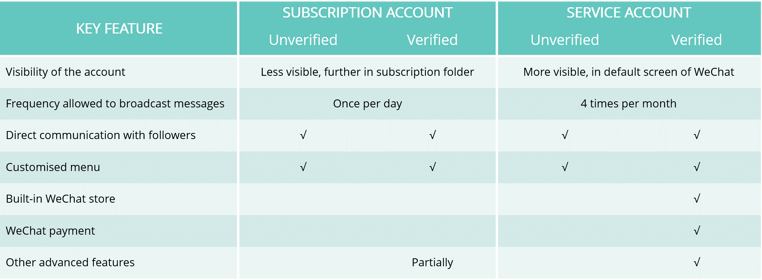There are few Australian companies that have been able to crack the WeChat marketing code, and Chatty Kids, an educational platform that helps kids learn how to read and speak English, is one of them. At this year’s Access China Summit, Chatty Kids founder Ken Taggart spoke about how his start-up have used WeChat to win over Chinese consumers, and what lessons he has learned about WeChat marketing along the way. Here are some of the key takeaways from his presentation.
Use WeChat to reach Chinese consumers
In a country where email is rarely used, it is crucial to find other means of communicating with consumers directly, and social messaging app WeChat, with over 889 million monthly active users, is one of the key platforms.
By simply scanning a QR code, whether that code is online via a website or Moments post, or out in the real world, businesses can instantly initiate a conversation with that user, while also prompting that user to follow the business’s WeChat Page (which is necessary if the user wants to be able to receive messages from that account). This then allows that user to be tagged and their behaviour to be tracked as they move through the sales funnel, providing accurate data on the effectiveness of any given campaign.
This ability
- Communicate with consumers directly, and
- Collect analytics that enable you to measure the success of a campaign
are the key reasons why WeChat marketing has been a major focus for Chatty Kids, and how Chatty Kids has managed to achieve success in the Chinese market.
How to advertise on WeChat: Lessons learned
Like any start-up, Chatty Kids has had to learn many lessons the hard way, through trial and error.
Here are 3 of the lessons Taggart learned about how to advertise on WeChat to reach the Chinese audience:
- Be sure to use the right WeChat account
- Use the right key opinion leaders (KOLs) for your target market
- Learn how to manage WeChat groups
Be sure to use the right WeChat account
When setting up a public WeChat account for your business, it’s first essential to understand the difference between a service account and a subscription account. There are several differences between these accounts, some of which are outlined briefly below, but one of the key differences is the number of messages you are able to send users.

In a nutshell, a service account is much more visible, as it appears in the same screen as your other WeChat friends, while Subscription accounts are located in a separate folder. Messages and updates from Service accounts also get a push notification, just like when you receive messages from friends. However, with a Service account, you are only able to send 4 messages a month.
With a Subscription account, on the other hand, what you sacrifice in visibility, you make up for in frequency, as you are able to send 1 message daily. It’s therefore more suited to businesses whose leads require more nurturing in order to move them down the funnel.
Because Chatty Kids is a “boring, educational product” (Taggart’s words), a Subscription account works well for them, because they can send frequent messages encouraging parents to try the product. “We’re not Minecraft,” said Taggart. “It’s hard to get kids to do that [i.e. give the product a go].”
However, as Taggart said, businesses need to think carefully about whether it serves them to have such frequent communication with leads, as these can become “spammy”.
Use the right key opinion leaders (KOLs) for your target market
KOLs have a very large and highly engaged base of followers, which is why they can be a fantastic way to tap into your target market. It is important, however, that the KOL is appropriate to your brand, as Taggart found out.
KOLs have a very large and highly engaged base of followers.

To test the waters, Chatty Kids ran a KOL campaign with Australian teacher David Gulasi (@DavidHohhot), who became a viral sensation on Weibo after a video of himself correcting people’s English resulted in 71,100 reblogs. He has since amassed a huge following of over 8 million people. Gulasi posted an advertorial endorsing Chatty Kids on his Weibo page, with a website link at the bottom of the article. The article was viewed over 531,000 times; however, only 1499 people actually clicked on the link.
Why was the engagement so low? Because the demographic was wrong. Gulasi’s audience was largely teenagers studying for their IELTS exams; Chatty Kid’s key demographic was young parents with young children.
There were also other errors: the article originally ran with a QR code linking to Chatty Kid’s WeChat page, which worked poorly from within Weibo. Once the code was replaced with a website link, engagement went up.
The article was also low quality, which Taggart felt may also have affected engagement – it can be difficult to find good marketing resources in China, said Taggart, particularly if you don’t speak Chinese.
When asked where to find appropriate KOLs, Taggart said it was “difficult”, saying candidly, “I haven’t solved that problem yet.” While there are sites that provide lists of KOLs, their numbers are so often exaggerated that it can be difficult to gauge their impact. So far, networking has proved the most effective way of finding good KOLs.
Learn how to manage WeChat groups
WeChat groups allow you to create online communities around an interest related to your brand, which can be great for marketing purposes as these groups tend to have an engaged following and high visibility. Unfortunately, though, they are difficult to scale, as the number of people that can join a group is limited to 500 people.
WeChat groups allow you to create online communities around an interest relates to your brand.
Chatty Kids discovered this during a B2B2C campaign that they ran with a distributor, a company called Zhihuishan, which teaches children how to write in Chinese. In a revenue share agreement, Zhihuishan would promote Chatty Kids to their followers, who are of a very similar demographic to that of Chatty Kids. Zhihuishan did not, however, want to drive users directly to Chatty Kids’ WeChat page, so users were instead being driven to WeChat groups. As each group reached its limit, it was up to Chatty Kids to manage this process manually, as there was no API within the WeChat suite to facilitate this. This, says Taggart, is still a problem he is trying to solve.
What’s next for Chatty Kids?
As a growing start-up, Chatty Kids is on the lookout for further opportunities. They are looking to connect with corporate partners, and continue promoting the product within schools, and Taggart says there are huge opportunities in forums, which currently boast the fastest growth in traffic.











